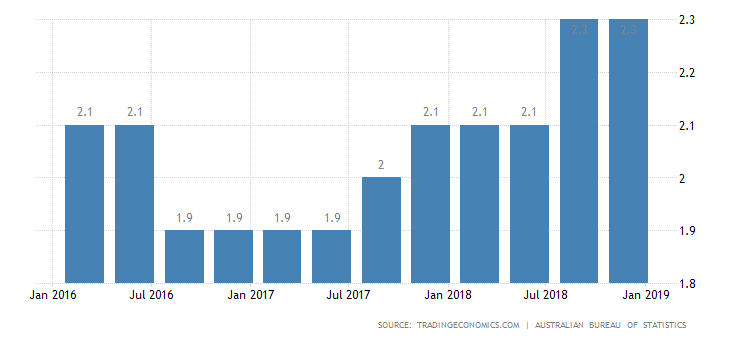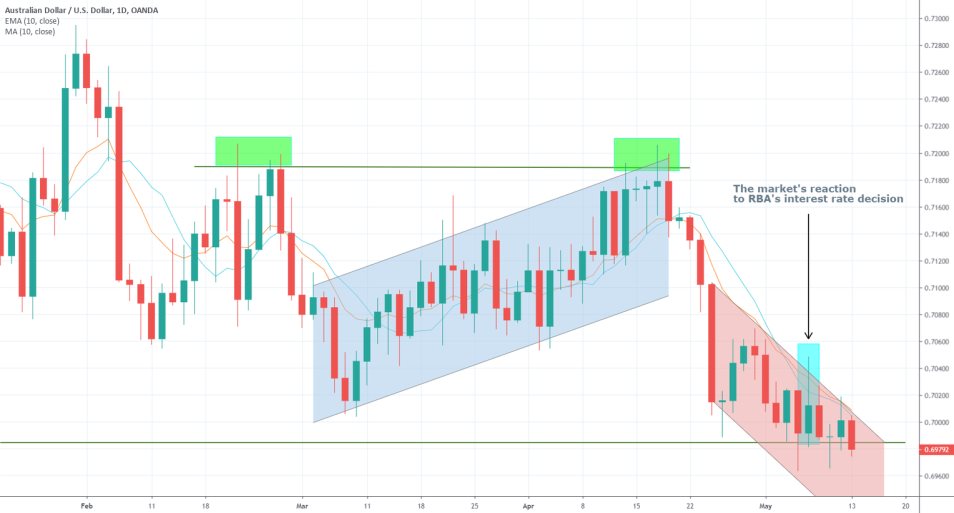
The Australian Bureau of Statistics is scheduled to release the newest labour data, regarding the monthly change in employment numbers and the overall unemployment rate for the Aussie economy this Thursday. The overall market forecast is for a total of 15.2k new jobs to have been added for the month of April, which would measure an incremental decrease of close to 10 thousand compared to the data for March, and the underlying rate is expected to remain at 5%.
In its previous statement, the Reserve Bank of Australia was overall cryptic in regards to its general opinions about the state of affairs in the national labour market, stating that:
“There has been a significant increase in employment, the vacancy rate remains high, and there are reports of skills shortages in some areas. Despite these positive developments, there has been little further progress in reducing unemployment over the past six months” [source]
However, the RBA did not delineate its opinions in regards to the sustainability of the labour market, despite the increased demand for high-skilled workers, and whether the Australian economy has reached a point at which there is no more room for growth. In terms of numbers, the unemployment rate was sitting at 4.9% in February, which also measured an 8-month low, and yet the central bank does not anticipate any further reductions at least until 2021.
Seemingly, the RBA remains complacent for the time being with trying to maintain the underlying unemployment rate at around 5%, with a shifted focus towards promoting higher hourly earnings. It appears that at the present rate the central bank recognizes that there is not much that can be done to crunch the numbers of the prevailing unemployment rate, and for that reason, its primary ambition is to maintain the current momentum in wage growth.

In case that, the report on Thursday indicates a potential drop from the current level of 2.3% of the Australian annual change in hourly rates of pay, the local labour market would experience a noticeable hit in its best-performing sector at the present rate. That would also mean that the RBA would have tougher times ahead of itself to meet its inflation target-rate and it would also give certain credence to the recent market speculations that the RBA might be inclined to lower the interest rate to 1 per cent.
The AUDUSD pair is currently trading near the significant support level at 0.69841, as it bounced back from the 10-EMA following last week’s interest rate decision. Hence, the anticipated increase in volatility following the release of the labour data on Thursday can also be expected to check the strength of this level.

Trendsharks Premium
Gold is undergoing a correction, as investors take profits to offset losses from falling stock prices, impacting their margins. However, we anticipate a renewed wave of [...]
The Swiss stock market index is mirroring its global counterparts, such as Germany 40 and US100, experiencing a sharp decline following the announcement of new [...]
We’re analyzing the weekly chart to grasp the broader market trend. Over the past three years, the US30 index has surged by 17,000 points, often resembling a nearly straight [...]
Over the past week, the DAX has experienced a sharp decline, plunging by an astonishing 3,400 points. This downward movement is not isolated, as its international counterparts, such as the UK100 and US100, are also facing significant [...]
EURUSD recently formed a double top at 1.0930, signaling a potential trend reversal, and has since begun a correction. After a 600-pip rally since early March, a pullback at this stage is both expected and healthy. Given these conditions, we are placing a [...]
Since early March, EURJPY has surged nearly 1,000 pips, providing us with several excellent trading opportunities. However, as the rally matures, many early buyers are beginning to take profits, leading to a noticeable slowdown in the uptrend. On Friday, the pair formed a [...]
The AUDJPY currency pair continues to be dominated by bullish momentum, as multiple golden cross patterns reaffirm the strength of the ongoing uptrend. Despite this, we are witnessing a much-needed [...]
The EURAUD currency pair appears to be undergoing a trend reversal, signaling a potential shift in market direction. A notable technical development is the formation of a Death Cross on the chart, a widely recognized bearish indicator that typically suggests a [...]
After securing an impressive 200-pip profit last week, the EURJPY currency pair is now undergoing a southward correction, retracing some of its recent gains. Despite this temporary pullback, the Golden Cross remains intact, reinforcing our view that the overall trend continues to be [...]
The appearance of a Golden Cross in Silver strengthens our analysis that the metal is currently in a strong uptrend, indicating further bullish momentum in the market. This technical pattern, where the short-term moving average crosses above the [...]
This trade presents a considerable level of risk and can be classified as an opportunistic move based on recent price action. The GBPUSD currency pair has experienced a substantial bullish rally, surging by nearly 500 pips in a strong upward movement. However, after this extended period of appreciation, the pair is showing signs of a potential [...]
The anticipated Death Cross on the SMI20 appears to be failing as price finds strong support at the 23% Fibonacci retracement level. After testing this area, the index has shown bullish strength, printing several large green candles, signaling an increase in [...]
A Golden Cross has just appeared on the USDJPY chart, signaling a potential bullish move. This technical pattern occurs when the 20 period moving average crosses above the 60 period moving average, a widely recognized indication of increasing [...]
After 2 months of a down trend, we finally see some indications of price recovery for Oil. The golden cross, a historic buy signal, supports this [...]
For the past month, the German DAX40 has experienced a remarkable 10% surge, reflecting strong bullish momentum. Despite ongoing market volatility and frequent pullbacks, every dip continues to attract fresh buyers, reinforcing the [...]
Oil continues its downward trajectory, despite occasional pullbacks. The overall trend remains bearish, reinforced by multiple Death Cross patterns, a classic sell signal indicating further weakness. Adding to this bearish outlook, the critical [...]
Over the past few days, gold has experienced a sharp decline of more than $100. This downturn can be attributed in part to traders securing profits to manage their margins, which are under strain due to the significant drop in major indices. Currently, gold has fallen below the [...]
The NASDAQ 100 index is showing strong bullish momentum, as evidenced by the formation of a Golden Cross on the chart. This classic buy signal occurs when the short moving average crosses above the long term moving average, suggesting that upward momentum is [...]
The EURAUD currency pair has encountered a significant resistance level, failing to break above the critical 61% Fibonacci retracement level. This suggests that bullish momentum is weakening, reinforcing the case for a potential downward move. Given this technical setup, we favor entering a [...]
The UK100 is experiencing a remarkable rally! Over the past few weeks, the British stock market index has surged nearly 800 points. Each minor dip has attracted more buyers, fueling the bullish momentum. However, since last week, we’ve observed a slight [...]




















